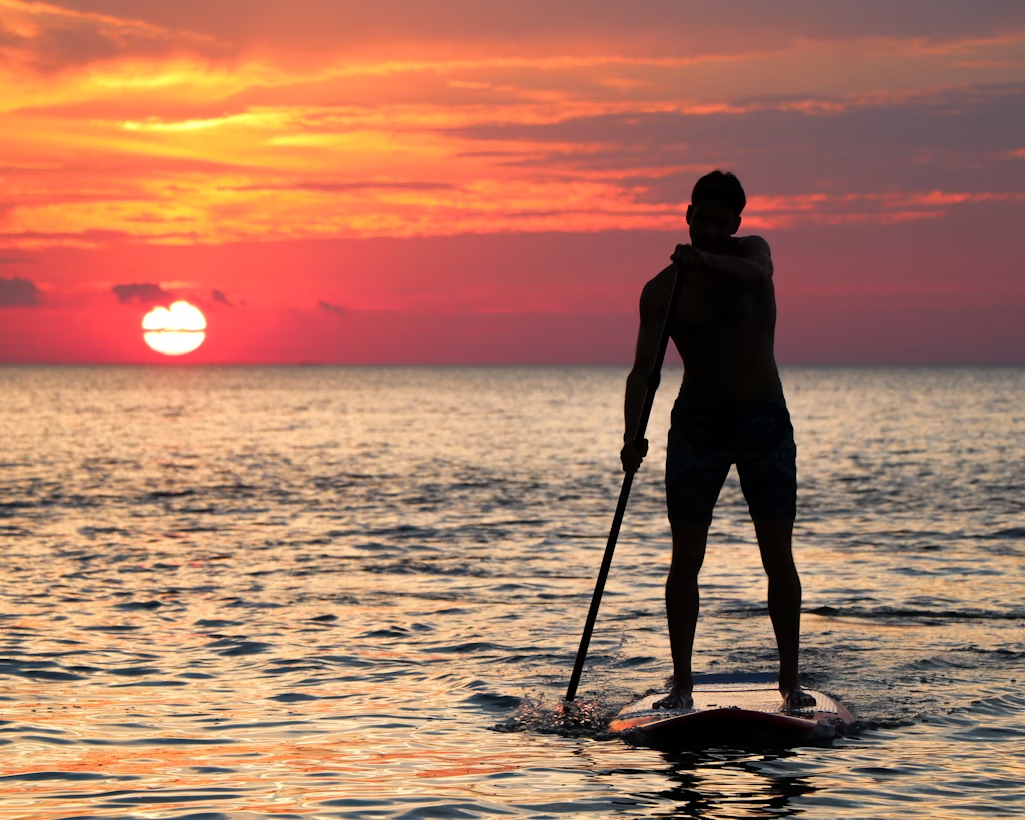Paddleboarding has taken the world by storm, bringing both thrill and tranquility to water lovers everywhere. Whether gliding through calm waters or riding ocean swells, paddleboarding offers something for everyone. Among the most popular forms are prone paddleboarding and stand-up paddleboarding (SUP). This article will delve into these styles, helping you discover which might be the perfect match for your needs and lifestyle.
What is a Prone Paddleboard?
A prone paddleboard is a unique type of board that differs significantly from a SUP. According to REI’s definition of prone paddleboarding, this activity involves lying down or kneeling on the board and propelling yourself with your hands. Here are some key features and benefits:
- Design and Features:
- Size and Shape: Prone paddleboards are generally narrower and longer than SUPs.
- Materials: They are typically crafted from lightweight materials like epoxy or fiberglass to enhance speed and performance.
- Benefits:
- Intense Workout: Since movement relies on hand paddling, it offers a rigorous upper body workout.
- Stability: With a lower center of gravity, it provides excellent stability, especially in choppy waters.
These unique qualities make prone paddleboarding an excellent choice for those seeking a full-body workout and a connection with the water.
What is Stand-Up Paddleboarding (SUP)?
Stand-up paddleboarding (SUP) is one of the most flexible water activities you can enjoy. Unlike prone paddleboarding, where you lie flat on the board, SUP involves standing up and using a long paddle to move through the water. This activity is accessible and great for a wide range of interests. Here’s what makes SUP so appealing:
- Versatility: You can do much more than just paddle. Activities such as yoga, leisurely touring, or even racing become possible on an SUP. According to Skyquest’s analysis, this adaptability is one reason for SUP’s growing popularity.
- Beginner-Friendly: SUP is great for those who are new to water sports. The standing position makes it easier to balance and navigate, which is appealing for beginners and those looking for a gentle introduction to paddling.
- Enjoyment Across Ages and Skill Levels: Whether you’re young, old, or somewhere in between, SUP suits almost everyone. Its wide appeal means you can easily join friends or family and have fun together on the water.
Comparing Prone Paddleboard and SUP
When deciding between prone paddleboards and stand-up paddleboarding, there are several factors to consider:
- Performance and Skill Level:
- Prone Paddleboard: Offers a challenging experience because you mainly use your arms to paddle while lying down or kneeling. Though intense, this can be rewarding for those looking to enhance their fitness level.
- SUP: Easier learning curve thanks to the upright position and paddle. More straightforward to master balance and movement.
- Physical Benefits:
- Prone Paddleboard: Engages the upper body and core more intensely, offering a calorie-burning workout unique to its method.
- SUP: Provides a whole-body workout that combines core strengthening with balance and endurance training. It’s a great way to get fit while having fun.
- Equipment and Cost:
- Prone Paddleboards: Prices vary, but these can be more niche and less widely stocked. Consider browsing sites like West Coast Paddle Sports for a range of options.
- SUPs: Widespread availability and a booming market make SUPs more accessible. You will find a diverse selection in terms of prices and types suitable for beginners and advanced users alike.
- Purpose and Usage:
- Prone Paddleboard: Excels in racing scenarios and can handle rough waters. Ideal for those with a competitive edge or those seeking a full-on workout.
- SUP: Perfect for leisurely activities like touring and casual paddling in calmer waters, making it a preferred choice for those who see paddleboarding as a relaxing pastime.
Prone Paddle Board for Sale: What to Consider
Buying a prone paddle board can be an exciting venture, whether you’re new to the sport or a seasoned paddler looking to upgrade. To make an informed choice, consider these key aspects:
Quality and Build
- Materials: Prone paddleboards are often made from different materials like fiberglass, epoxy, or carbon fiber. Each offers varying levels of durability and performance.
- Design: Look for a board with a well-balanced design. A longer, narrower board may suit racing, while a wider board provides more stability.
Reputable Brands
Choosing a board from a reputable brand can ensure higher quality. Brands known for their reliable equipment offer better long-term value and warranty options.
Budget Considerations
- New vs. Used: New boards come with the latest features but are pricier. On the other hand, a used prone paddleboard for sale can be a cost-effective option if you check its condition thoroughly.
- Board Condition: When considering used boards, inspect for any damage or repairs that might affect performance. Look for signs of wear on the board surface and fin box.
Marketplace Options
You can find both new and used prone paddleboards from trusted retailers. They often provide a wide selection and useful customer reviews.
Choosing the Right Paddleboard for You
Selecting between a prone paddleboard and a SUP is a personal decision that depends on various factors. Here’s how you can narrow down the choice:
Personal Preferences
- Fitness Goals: Prone paddleboarding is more intense, offering a comprehensive upper-body workout. SUP is versatile, suitable for activities like yoga or leisurely paddles.
- Skill Level: If you’re a beginner, SUP might be more approachable. But if you enjoy a challenge, prone paddling could be the way to go.
Environmental Factors
- Local Waterways: Consider where you’ll be paddling most often. Calm lakes may be suitable for both, but prone paddleboards might shine in rougher conditions like open oceans or competitive settings.
Checklist
- Purpose (racing, fitness, leisure)
- Think about your primary use case
- Local water conditions
- Ideal board length and width for your needs
In conclusion, your perfect paddleboard choice aligns with personal preferences, fitness aims, and the conditions you’ll face while paddling. Take the time to evaluate each factor thoroughly, and you’ll embark on a fulfilling paddleboarding journey. For available options, you can explore selections at trustworthy retailers, ensuring you find the right fit for your adventure.
For more information, check out the SUP beginner’s guide by Blue Planet Surf.
Your Paddleboarding Adventure Awaits
Choosing between a prone paddleboard and a SUP can be an exciting journey into the world of paddle sports. Both offer unique experiences and benefits. Here’s a quick recap to help you decide:
- Prone Paddleboards: Offer a hands-on, intense workout and are great for those seeking a stable and vigorous exercise.
- SUPs: Versatile and beginner-friendly, perfect for exploration, yoga, or simply enjoying time on the water.
As you step into paddleboarding, consider trying both types to find what suits your lifestyle and preferences.
Here’s how to start your adventure:
- Visit a trusted retailer to explore various options.
- Attend local paddleboarding events or workshops to test different boards.
- Talk to seasoned paddlers for insights and personal tips.
No matter which option you choose, embrace the thrill of paddleboarding and enjoy the exhilarating moments on the water. Your journey to finding the perfect paddleboard starts today!






